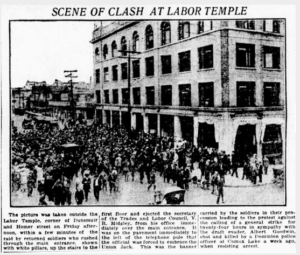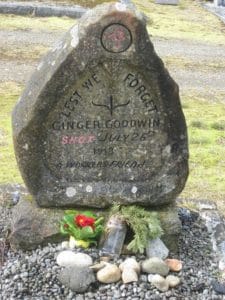100 years ago, on a late July day on Vancouver Island, a man was shot in the hills near Cumberland. According to a friend, Ginger Goodwin had just finished picking blackberries when he encountered a special constable of the Dominion Police. What happened next remains shrouded in uncertainty even a century later, but we know that by the end of it Goodwin was dead with gunshot wounds to his wrist and neck, and a severed spinal cord. His death made him a martyr for the growing labour movement and sparked the first general strike in Canada’s history.
 Albert “Ginger” Goodwin was born on May 10, 1887 in Yorkshire. On September 2, 1906, he stepped off the SS Pretoria in Halifax harbour and began the journey that ended with his shooting on the other side of the country twelve years later. Working as a coal miner, his life became a cycle of labour organizing, strikes, and company blacklisting that forced him to pack up every couple of years to seek work elsewhere. By 1916 he had settled in the town of Trail in the Interior of British Columbia. There, he became secretary of the International Union of Mine, Mill, and Smelter Workers.
Albert “Ginger” Goodwin was born on May 10, 1887 in Yorkshire. On September 2, 1906, he stepped off the SS Pretoria in Halifax harbour and began the journey that ended with his shooting on the other side of the country twelve years later. Working as a coal miner, his life became a cycle of labour organizing, strikes, and company blacklisting that forced him to pack up every couple of years to seek work elsewhere. By 1916 he had settled in the town of Trail in the Interior of British Columbia. There, he became secretary of the International Union of Mine, Mill, and Smelter Workers.
At that time, Canada was at war with Germany. As the Borden government moved towards a policy of conscription to replace casualties overseas, it faced resistance from both nationalists in Quebec and socialists like Goodwin across English Canada. Initially, Goodwin was judged unfit for duty due to a respiratory disease he had contracted in the mines, but on March 7, 1918 he was suddenly reclassified as fit for service. Rumours circulated that his employer, who was friends with the head of the exemption tribunal, wanted to get rid of him in retaliation for leading a strike the previous year.
Left with no legal recourse, Goodwin fled to the wilds of Vancouver Island where he and others like him were fed by sympathetic locals and hunted by the police. It was there that he was killed on July 27 by Dan Campbell, a disgraced BC Provincial Police officer fired for extortion. Campbell would later claim Goodwin pointed a gun at him and that he shot in self-defence, but according to Goodwin biographer Susan Mayse the position of the gunshot wounds suggest that Goodwin was shot from the side, causing the bullet to ricochet off his wrist and into his neck.
 There were no witnesses to the shooting, but news of what Goodwin’s supporters saw as a state-sponsored assassination spread throughout the province. Unions in Vancouver organized a one-day general strike on August 2 in protest. Pro-war mobs attacked trade unionists in the streets and forced them to kiss the Union Jack. Meanwhile, a grand jury in Victoria decided not to charge Campbell with manslaughter despite (or perhaps because of) glaring irregularities in the police investigation. A traitor to some and a martyr to others, Goodwin today rests under a headstone marked by a hammer and sickle and the simple words “a worker’s friend”.
There were no witnesses to the shooting, but news of what Goodwin’s supporters saw as a state-sponsored assassination spread throughout the province. Unions in Vancouver organized a one-day general strike on August 2 in protest. Pro-war mobs attacked trade unionists in the streets and forced them to kiss the Union Jack. Meanwhile, a grand jury in Victoria decided not to charge Campbell with manslaughter despite (or perhaps because of) glaring irregularities in the police investigation. A traitor to some and a martyr to others, Goodwin today rests under a headstone marked by a hammer and sickle and the simple words “a worker’s friend”.
Enjoy interesting historical tales? Be sure to join us on our new BUBBLE TOURS in Kingston, Ottawa & Toronto. A safe and fun way to get some fresh air and enjoy some great ghost stories and dark history.
Written By: Edward Roué
Tour Guide
The Haunted Walk of Ottawa
